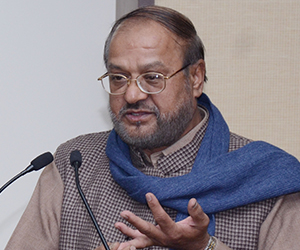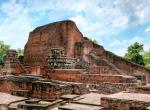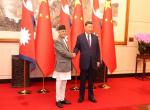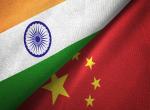Recently in a TV interview, Mr. Harish Salve said that to a few Bharatiya Janata Party (BJP) leaders he had said, “you may have got the absolute majority but please do not underestimate the destabilising powers of media, political activists, and people taking recourse to the court cases by filing Public Interest Litigations (PIL)”.
In the last three months most of the public discourse and media space have been taken away by the cacophony of the opposition in the name of ‘saving constitution’ and the ‘dignity of the Supreme Court judges’. Lawyers having political affiliations or loyalties to different opposition parties have come together under the leadership Congress to ‘save the Constitution and the dignity of judges’. Even the president of the Congress Party has called the Chief Justice of India (CJI) a ‘bench fixer’, citing certain politically motivated PILs. In order to threaten the Judiciary they are spreading falsehood and threatening judges with frivolous allegations, and even impeachment. It is, therefore, important to look at the history as to how these forces have done the damage to the prestige and dignity of the Judicial institution and the Judges in the past.
When we look at the issue in historical perspective, we find that the Congress and the Communists have been undermining the dignity and independence of judiciary. It all began in the early days of independence. Justice B.P. Sinha recounts that when Justice Harilal J. Kania, the then Chief Justice of India (CJI), died suddenly and prematurely due to a heart attack on 6th November 1951, the Prime Minister was inclined to supersede Justice M. Patanjali Sastri, Mehar Chand Mahajan and B.K. Mukherjea in favour of Justice S.R. Das as the CJI. But, as Justice Sinha mentions, an ‘unwritten law’ prevented this to happen. 1 Justice Patanajali Sastri finally took oath after working a couple of month as the Acting CJI. This was the only time that Supreme Court of India had an acting Chief Justice.
After the retirement of Justice Patanjali Sastri, Pandit Nehru wanted to supersede Justice Mehr Chand Mahajan to the post of CJI as both could not see eye-to-eye on Kashmir issue where Mahajan was the Prime Minister during most difficult times, i.e. between 1946 and 1947. They both had corresponded bitterly and complained to Sardar Patel that other one was not listening. Mahajan had warned of a disaster On Kashmir issues. Sardar Patel used to take the role of mediator between the two. Pandit Nehru was unhappy that Mahajan was elevated as a judge in Supreme Court. After CJI Patnajali Sastri’s retirement on 3rd January 1954, the Nehru government wished to bring in M.C. Chagla from Bombay High Court directly as the Chief Justice of India.2 The Supreme Court judges not only resisted such a move but even told the Congress government that if, “you want a Chief Justice other than Mahajan you might as well think of having a whole new Supreme Court.”3 Justice S.R. Das, who was being persuaded to take over as the CJI, told Pandit Nehru that he would resign rather than taking oath. Between 1954 and 1973, relationship between the bureaucracy and the judiciary were not in best of terms. Bureaucracy often had its way in getting appointed people of its choice. But at the same time, if the CJI did not want a person and set his foot down, then bureaucracy reconciled. But the things remained far away from the glares of the public eye.4
The real onslaught on judicial independence and judges’ dignity began with Mrs. Indira Gandhi’s government. After losing the Kesavananda Bharati case5 Mrs. Gandhi not only decided to bring the Supreme Court to its knees but also teach a lesson to dissenting judges. In Kesavananda Bharati case, the judgment was pronounced on 24th April, 1973 and the CJI Justice S.M. Sikri was to retire the following day. After Sikri, three most senior judges were Justices J.M. Shelat, K.S. Hegde and A.N. Grover, in that order. Immediately after the pronouncement of the judgement, the Political Affairs Committee of the Cabinet met on 24th April itself and decided to appoint A.N. Ray as the CJI, superseding three most senior judges. All India Radio, in its 5 p.m. bulletin on 24th April, announced the appointment of A.N. Ray as the CJI. S.M. Sikri and three most senior Justices Shelat, Hegde and Grover resigned. Thus, the judges were punished for not towing the line of the Government of the day.
Congress leaders like Rajani Patel, Mohan Kumarmangalam and many other have been talking about “packing the Supreme Court with judges committed to the government.”6 Mr. Mohan Kumaramangalam, S.S. Ray, H.R. Gokhale and many other in the Congress had been saying openly that “… supersession had been spoken in the party and among Indira’s advisors for a long time, since winter, at least.” Judiciary was seen as a hurdle in the path of the Government.7 “Law Minister Gokhale confided, some years later, that the ‘Prime Minister, Siddhartha [Ray], and Kumarmangalam were adamant, and the Prime Minister was worried of Hegde becoming Chief Justice…. [because] Hegde’s decision was against the Prime Minister’s interest.” According to her personal Secretary, N.K. Seshan, “Indira Gandhi was bent on getting rid of Hegde. She was the moving force behind it.”8 Hegde was thus superseded purely on ideological grounds and personal considerations. Gokhale, S.S. Ray and Kumaramangalam recommended Justice A.N. Ray as according to most accounts, he was expected to be ‘pliable’ as well as liberal. “Mohan and Gokhale told Indira that A.N. Ray was the best”, said Sheila Dixit. 9
The matter did not end here. The process was repeated when it was the chance of Justice H.R. Khanna taking the oath of CJI. Congress and Mrs. Gandhi could not forget that in Kesavananda Bharati case it was Justice H.R. Khanna who sided with the concept of basic tenets of the Constitution which cannot be altered by means of amendments, as decided in the Golak Nath case.10
Justice H.R. Khanna, during emergency, gave the dissenting judgement in the popularly known as Jabalpur ADM case11 or Habeas Corpus case that under no circumstances fundamental rights and the right to life of citizens can be suspended to give unlimited powers to the executive to take away life and liberty and deny the judiciary its ‘sentinel’ role and so violate one of the basic tenets of the Constitution. Justice Khanna wrote in the judgement that: “Law of preventive detention, of detention without trial, is an anathema to all those who love personal liberty. Such a makes deep inroads into basic human freedoms which we all cherish and which occupy prime position among the higher values of life…. Even in the absence of fundamental rights the state has got no power to deprive a person of his life or personal liberty without the authority of law. That the essential postulate and basic assumption of the rule of law in every civil society.”12 Hearing the judgment Jayaprakash Narayan spoke for the hapless Indians: “The decision has put out the past flickering candle of individual freedom. Mrs. Gandhi’s dictatorship both in its personalised and institutional form is now almost complete.”13 The censor did not allow News Papers to report Justice Khanna’s dissenting judgment. The other four judges, namely A.N. Ray, M.H. Beg, Y.V. Chandrachud and H.N. Bhagvati, gave the judgement what Mrs. Gandhi wanted. Thus, the case was decided four vs. one. The emergency detunes remained in jail without trial and without any right to life.
Justice H.R. Khanna was the last of the seven judges who held that while Parliament is entitled to abridge some ports of fundamental right or amend any provisions of the Constitution in exercise of its amending powers, it cannot destroy the basic structure or framework of the Constitution and cannot take away what is Part III of the Constitution, i.e. Fundamental Rights. Of those seven judges who had given majority judgment in Keshvanand Bharati case that certain base structure of the Constitution cannot be amended, Chief Justice S.M. Sikri resigned and retired the next day of delivering the judgement i.e. on 25 April, and Justices J.M. Shelat, K.S. Hegde and A.N. Grover resigned upon being superseded for the office of the CJI. Justice A.K. Mukherjea died in harness and Justice P. Jaganmohan Reddy retired in due course. The last continuing judge of the seven who held that the constitution cannot be made to suffer a loss of identity through amending process was Justice H.R. Khanna. Justice Khanna resigned on 28 January 1977 when he, the senior most judge in the Supreme Court, was superseded by the Congress Government for Chief Justiceship. Of the six judges constituting minority judgement in Keshvanand Bharati case, Ray had already become the CJI and the rest three still serving ones went on the become CJI when their turn came.
However, it is important to recount the aftermath of this landmark judgment decided by four vs. one. After the judgement was delivered, Ashok Sen, Nehru’s Attorney General and Indira Gandhi’s lawyer in the election case, called on Khanna to congratulate him for saving the grace of Indian Judiciary. Niren De, the then Attorney General, took Khanna aside at a tea party and said, “May I offer my congratulations for your great judgment.”14 Chandrachud and Beg were to lament later in the life for giving judgement in fear. Speaking to the FICCI on 22 April 1978 Chandrachud said: “I regret that I did not have the courage to lay down my office and tell the people, well this is the law.”15 Justice Beg, while giving a ruling in a post-emergency case, said: “[T]hat the Habeas Corpus ruling was perhaps misleading as it gave the impression that no petition at all would lie under either Article 32 or 226 to assert the right of personal liberty because the locus standi of the citizens were suspended.”16
The exclusion of judiciary from the scrutiny of the constitutional amendments was not the end in itself. The independent judges were harassed, punished and blackmailed while the amenable ones were given promotions and rewards like Padma awards, nomination to commissions and nominations to the Rajya Sabha. Mrs. Indira Gandhi’s government resorted to the transfer of judges from one High Court to another and that too from one corner of the country to another. This made judges very unsettled and venerable. During the emergency, on the pretext of achieving national integration, 16 High Court judges were transferred just in one go. Dealing with the transfer case during the emergency and this innovative method of national integration, Justice Y.V. Chandrachud observed: “There are numerous other ways of achieving national integration more effectively than by transferring the High Court Judges from one High Court to another… Considering the great inconvenience, hardship and possibly a slur which a transfer from one High Court to another involves, the better view would be to leave the Judges untouched and take other measures to achieve that purpose. If at all, on mature and objective appraisal of the situation, it is still felt that there should be a fair sprinkling in the High Court judiciary of persons belonging to other States, that object can be more easily and effectively attained by making appointments of outsiders initially.”17
During the emergency a large number of Additional Judges in various High Courts were denied routine extensions or confirmation. These judges were mostly those who had ruled against the unlawful detention of ordinary citizens during the emergency. This included Mr. R.N. Aggrawal, Additional Judge of Delhi High Court, who had ordered the release of Kuldip Nayar from preventive detention. In 1980, when Congress returned to power, five High Court Chief Justices were retired without being confirmed. Additional Judges were being given extensions or given appointments only at the last moments and were made to make several demeaning statements. The Congress Party leaders and the Government left no stone unturned to malign and demoralise the judges. A cabinet Minister of the Congress government had bracketed the whole judiciary with the opposition parties just because the judges would just not do what the Congress government wanted. Not only the Congress party and the Congress government were talking about a Committed Judiciary, but one of the law ministers went as far as to issue a letter to each judge through the State Chief Ministers stating that: “The Government of India thinks very highly of those ‘value-packed’ judges who never rule against the Government, and will consider favorably their promotion to the Supreme Court.” Indeed, a letter of blackmail.
Congress and Mrs. Gandhi were not satisfied only by crushing the highest judiciary but also incorporated several Amendments (Amendments 24 to 42) in the Constitution, making the Constitution subservient to her. Inheritance of that legacy has to be prevented.
References:
1. Justice B.P. 1985, Sinha, Reminiscences and Reflections of a Chief Justice, p. 71.
2. G. Austin, 1999, Working a Democratic Constitution, p. 134; also see M.C. Chagla, 1978, Roses in December, pp. 170-72
3. P.K. Chatterjee in an Interview to G. Austin, 1999, Working a Democratic Constitution, p. 134.
4. For details see Gerge H. Gadbois, Jr. 2011, Judges of the Supreme Court of India 1950-1989. OUP; Abhinav Chandrachud, Supreme Whispers: Conversations with Judges of the Supreme Court 1980-1989, 2018, OUP. (This book is based on 116 Interviews with 66 judges (retired and sill in service then) of the Supreme Court by George H. Gadbois Jr.)
5. Kesavananada Bharati v.State of Kerala, AIR1973 SC 1461: (1973) 4 SCC 225.
6. Stateman, 3 May, 1973.
7. Chandrjeet Yadav’s interview to Granuville Austin, 1999, Working a Democratic Constitution, OUP, 1999, p. 280-81.
8. Granuville Austin,1999, Working a Democratic Constitution, OUP, 1999, pp. 283-84.
9. Ibid.
10. Golak Nath v State of Punjab, (1967) 2 SCR 762: AIR 1969 SC 1643.
11. A.D.M. Jabalpur v. Shivakant Shukla, AIR1976 SC 1207: (1976) 2 SCC 521.
12. Ibid.; Supreme Court Reporter, p.246; see also N.A. Palkhiwala, 1997, We the People, p. 298.
13. Statement issued on 15 May 1976; Narayan Papers Subject file 323, NMML.
14. Granuville Austin,1999, Working a Democratic Constitution, OUP, 1999, pp. 341-42.
15. Hindustan Times, 23 April, 1979
16. Upendra Baxi, Indian Supreme Court, p.111.
17. Y.V. Chandrachud in Union of India v. Sankal Chand Himatlal Sheth and others; Date of Judgment 19.09.1977.
(The paper is the author’s individual scholastic articulation. The author certifies that the article/paper is original in content, unpublished and it has not been submitted for publication/web upload elsewhere, and that the facts and figures quoted are duly referenced, as needed, and are believed to be correct). (The paper does not necessarily represent the organisational stance... More >>
(The Author is a Professor & Founder Director of Delhi Institute of Heritage Research and Management.)
Image Source: http://www.streenews.com/wp-content/uploads/2017/09/judiciary.jpg









_1_0.png)

Post new comment